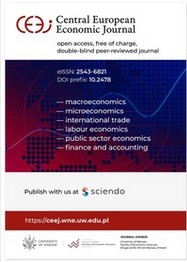Investment Activity of Local Administrative Units and the Level of Entrepreneurship Development in the Rzeszów Functional Area
Investment Activity of Local Administrative Units and the Level of Entrepreneurship Development in the Rzeszów Functional Area
Author(s): Grzegorz Ślusarz, Marek Cierpiał-WolanSubject(s): Business Economy / Management, Public Administration, Government/Political systems, Socio-Economic Research
Published by: Wydawnictwa Uniwersytetu Warszawskiego
Keywords: functional areas; synthetic measures; integrated territorial investments; typology of investment behaviour;
Summary/Abstract: The article presents preliminary results of research on the effectiveness of cohesion policy in relation to functional areas that benefit from integrated territorial investments. Assuming that all local government units in their strategies assume economic development based on the development of entrepreneurship, an attempt was made to assess the impact of investments on their development. At this stage of the research, the investments of local governments in terms of value were taken into account without considering their types and structure as well as sources of financing. Initially, the purpose was to examine whether the scale of these investments translates into the economic sphere: into the development of entrepreneurship. To assess the differences in the level of entrepreneurship in 2012 and 2016, the analysis of quantitative changes in business entities, the dynamics of their number and the synthetic indicators were used. The basis for the calculation of synthetic indicators were the methods of taxonomic analysis, that is, a simple aggregate measure, the Hellwig taxonomic development pattern method and the positional method using the Weber median. The Theil standardized index was used to examine the level and structure of spatial inequalities of gmina investment expenditures and enterprises’ investments. The research indicated the specificity of the Rzeszów Functional Area (ROF) both in comparison with the voivodeship and similar functional areas in eastern Poland. However, these are still insufficient means to increase the cohesion of the entire area and fully activate its endogenous potential. Synthetic analysis of the level of entrepreneurship indicates that in 2012–2016, a significant improvement in the indicators characterising economic entities operating in ROF occurred, compared to the voivodeship and the country. On the basis of a comprehensive assessment of the dependence of investment expenses of gminas (LAU 2) and enterprises, the difference in the distribution of types of investment behaviour between Podkarpackie Voivodeship and the Rzeszów Functional Area is clearly visible. The phenomenon of synergy of activities of self-government and entities occurs in 31% of gminas in ROF and only in 12% of gminas in the entire voivodeship. Thus, the types of investment behaviour of gminas and enterprises as well as the spatial distribution of economic activity indicate that the socio-economic potential of the city of Rzeszów and the benefits of the agglomeration resulting from it are more important than the implemented investments by individual gminas.
Journal: Central European Economic Journal
- Issue Year: 5/2018
- Issue No: 52
- Page Range: 40-55
- Page Count: 16
- Language: English

